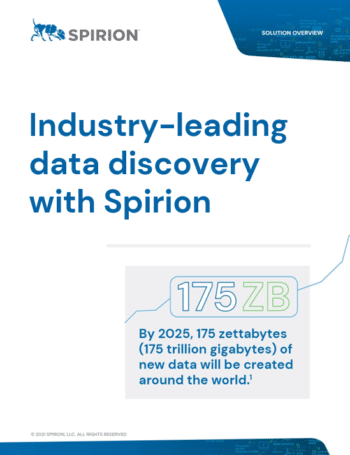
BY SPIRION
September 22, 2023
In today’s data-driven world, organizations are grappling with an unprecedented influx of data, and ensuring its protection has never been more challenging. With data scattered across diverse on-premises and cloud environments, and often existing in unstructured formats, the task of safeguarding sensitive information has become a daunting endeavor for IT executives and security teams. This article delves into the critical importance of accurate data discovery in comprehensive data protection, shedding light on how it can shape the security landscape and mitigate risks effectively.
The Data Deluge and its Dispersal
With the data landscape expanding rapidly, organizations are generating a staggering amount of data every day. In 2023 alone, they are expected to generate 120 zettabytes, and this number is projected to surge to 181 zettabytes daily by 2025. However, it’s not just the sheer volume of data that poses a challenge; it’s also the dispersion of data across numerous locations and its various forms.
Data is stored on on-premises servers, cloud platforms, and comes in different formats, making it increasingly challenging for CISOs, CIOs, COOs, and IT administrators to protect every byte effectively. Today, accurately and completely identifying every byte of data has become more difficult than ever, which increases the risk of unauthorized access or misuse.
To address this risk, IT leaders are realizing the importance of robust data discovery capabilities. They recognize the need for discovering, classifying, and remediating data efficiently and thoroughly. Consequently, they are actively seeking solutions and workflows that can provide them with a clear, complete, and accurate picture of their entire data operation.
By enhancing data structure, flow, and engagement, organizations can better navigate the evolving data landscape, ensuring data security, privacy, and compliance.
The Imperative of Accurate Data Discovery
As much as 90% of today’s enterprise data is unstructured — productivity documents, emails, photos, and social media posts — making it harder than ever to discover and index, due in large part to the diverse locations where it lives and the relatively little context traditional discovery tools have to find it.
These days, sensitive data can be anything from credit card data, financial, or other personally identifiable information (PII) to location data, genetic, and even biometric information. The strings of numbers and characters comprising this data all have the potential to match sensitive data formats, dramatically increasing the likelihood of a false positive alert.
False-positive data discovery means a data element is incorrectly identified as meaning one thing when in fact, it means something else. On the surface, false positives may not seem like such a big deal. But for already overwhelmed IT and security teams, wading through a flood of as many as 4,000 alerts per week can result in spending as much as 25% of their time chasing down false positives. That’s hundreds, if not thousands, of hours each year they spend investigating alerts that turn out to be dead ends that can distract them from real security threats and take them away from working on more important, higher-value IT initiatives and efforts.
Though, technology may never completely eliminate false-positive (and false-negative) identification, next-generation discovery solutions like Spirion Sensitive Data Platform brings a new and innovative approach to sensitive data discovery that consistently delivers an industry-leading 98.5% data discovery accuracy rate.
The platform provides a flexible hybrid approach to data discovery and classification with both software-based agents for on-premises servers or endpoints and agentless scanning in the cloud for simplicity, scalability, and performance. Specifically, the solution goes beyond simple pattern matching common to most of today’s discovery tools and applies more advanced techniques like branching algorithms, vector analysis, and regressions analysis to increase detection accuracy — and do it all automatically.
Revolutionizing Data Discovery Accuracy
Data privacy and protection has never been more important — or more difficult than it is right now. Comprehensive data protection strategies are only effective and impactful when organizations have complete visibility and transparency into their entire data universe.
But with the exponential growth in enterprise data, legacy data discovery tools and methodologies are putting organizations at higher risk of letting hidden bits of sensitive data slip through the cracks undetected and unprotected. Worse, it increases the likelihood of falling out of compliance with a range of data governance standards including GDPR, HIPAA, HITECH, CCPA, PCI DSS, and others that can have disastrous consequences for the company’s bottom line and their brand’s reputation.
Enhancing data discovery accuracy through automated and scalable tools that scour every operating system, cloud, or network-attached storage system is vital for improving your company’s overall data security posture. Not only will it cut down on wasteful false positive alerts and eliminate crucial visibility gaps, but it will also help to completely reshape your entire approach to data privacy and protection and provide unrivaled end-to-end data lifecycle coverage that stands up to the evolving challenges of business in the Digital Age.

